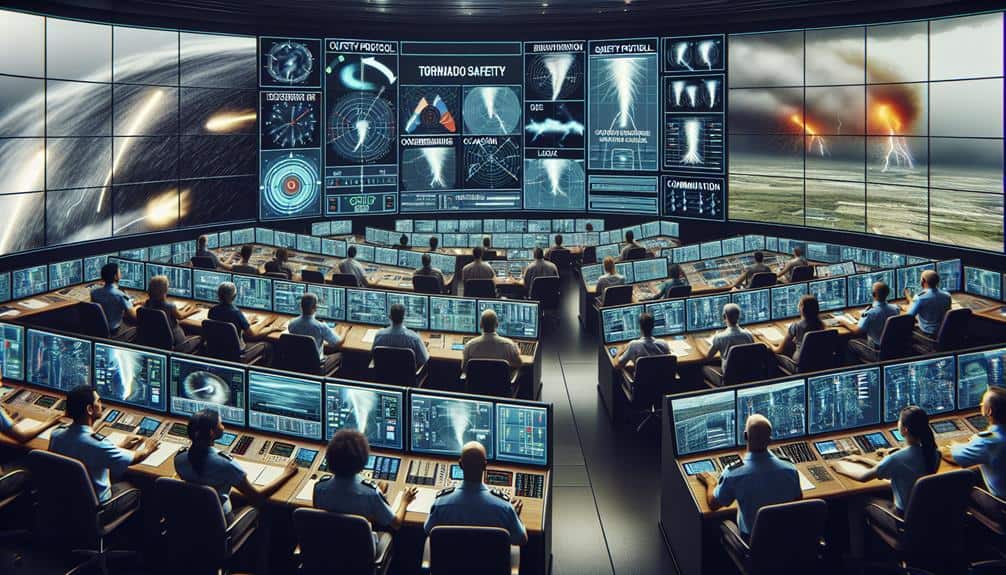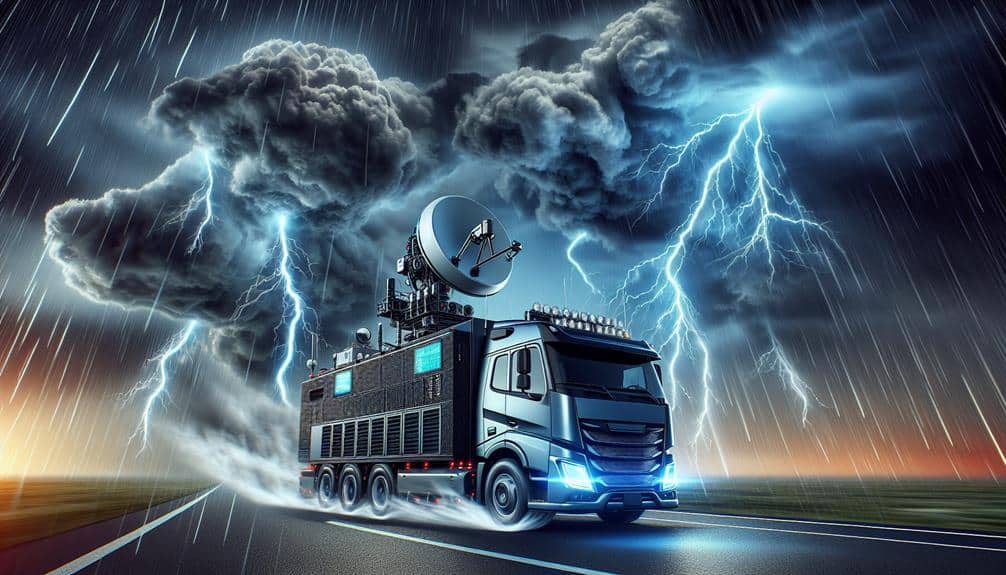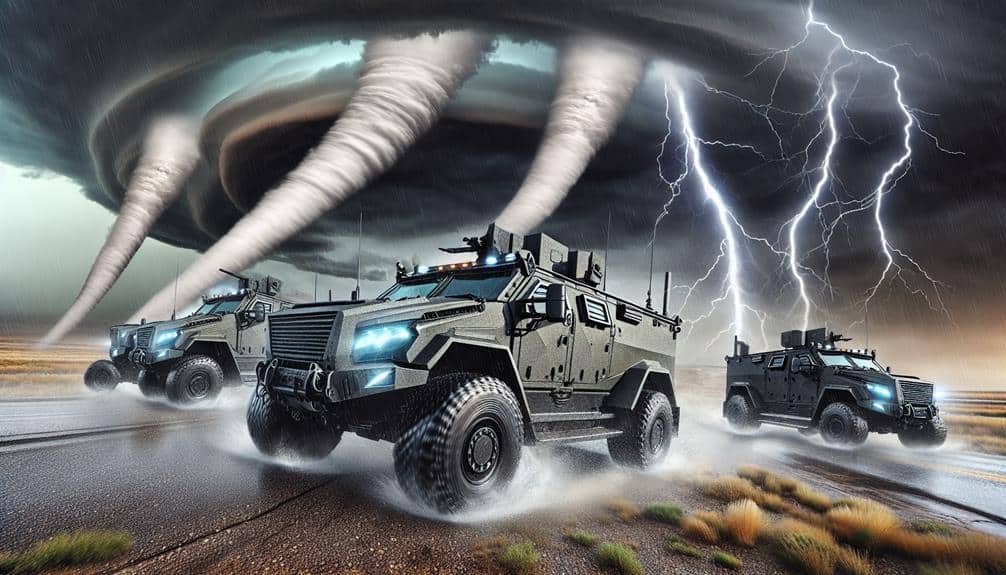We select state-of-the-art tornado tracking technology solutions because they provide us with unparalleled precision and real-time data. Sophisticated radar systems, like Doppler and dual-polarization, allow us to monitor atmospheric conditions with high precision. Real-time data analytics help us identify patterns and improve our predictive models continuously using machine learning techniques. Mobile tracking units enhance situational awareness and lead time for evacuations. Integrating these technologies with safety protocols guarantees effective emergency responses and instant communication of critical information. By staying updated with this technology, we can strengthen our emergency readiness and public safety strategies further. Interested in how it all works?
Key Points
- Provides real-time, high-resolution data for accurate monitoring and early warnings.
- Enhances public safety with precise and timely tornado alerts.
- Utilizes machine learning for improved predictive models and emergency response.
- Offers actionable insights and increased lead time for evacuations.
Advanced Radar Systems
Advanced radar systems provide unparalleled precision in tracking tornado formations and movements, leveraging Doppler technology to deliver real-time, high-resolution data. By employing dual-polarization techniques, we can differentiate between types of precipitation within storm systems, enhancing our ability to predict tornado development. This technology enables us to achieve precision accuracy in monitoring atmospheric conditions, essential for early warnings.
Remote monitoring capabilities allow us to track storm patterns from a distance, minimizing the risk to personnel and providing continuous data collection, even in the most hazardous situations. Our advanced radar systems operate using phased array antennas, which can scan entire sectors of the sky in milliseconds. This rapid scanning ability ensures that we capture the most up-to-date information, giving us a thorough understanding of storm dynamics.
Moreover, the integration of machine learning algorithms with radar data enhances our predictive capabilities. By analyzing historical storm data, these algorithms refine their models, improving the precision accuracy of our forecasts over time. As a result, communities gain crucial lead time to implement safety measures, ultimately preserving lives and property.
Embracing these cutting-edge radar systems empowers us with the freedom to make well-informed decisions, grounded in reliable, high-precision data.
Real-Time Data Analytics
Leveraging real-time data analytics, we can process and interpret vast amounts of meteorological data instantaneously, enhancing our tornado tracking and prediction capabilities. This cutting-edge approach allows us to harness the power of technology for remote monitoring, providing us with the freedom to make well-informed decisions quickly.
By analyzing data from multiple sources, including advanced radar systems and satellite imagery, we're able to:
- React promptly to emerging threats, guaranteeing timely disaster response.
- Identify patterns and trends that traditional methods might overlook.
Our data-driven, analytical approach means that we can continuously refine our models and predictions. This not only helps in tracking tornadoes more precisely but also optimizes the allocation of resources during disaster response. Real-time data analytics empowers us to stay ahead of the curve, mitigating potential damages and saving lives.
Remote monitoring plays an essential role in this process. It ensures that we've continuous access to the latest data, regardless of location. This freedom to monitor and respond dynamically is invaluable, especially when facing unpredictable and rapidly evolving weather conditions.
Enhanced Predictive Models
Refining our predictive models, we integrate sophisticated algorithms and machine learning techniques to forecast tornado activity with unparalleled accuracy. By leveraging extensive datasets and real-time atmospheric data, we can pinpoint potential tornado formations well in advance. This improved accuracy allows us to issue early warnings that greatly enhance public safety and preparedness.
Our models continuously learn and adapt, using historical storm data and current weather patterns to predict both the likelihood and potential path of tornadoes. These advanced predictive capabilities enable communities to act swiftly, reducing the risk of casualties and property damage. Our data-driven approach ensures that each prediction is backed by robust scientific analysis, allowing us to provide precise and timely alerts.
Enhanced emergency response is another critical benefit of our refined models. With accurate early warnings, emergency management teams can mobilize resources more effectively, guaranteeing shelters are prepared, and evacuation plans are executed smoothly. This proactive stance not only safeguards lives but also empowers communities to maintain their freedom and resilience in the face of natural disasters.
Mobile Tracking Units
Our mobile tracking units, equipped with state-of-the-art sensors and communication systems, allow us to monitor tornado activity in real-time and relay critical data to forecasting centers instantaneously. This capability is essential for guaranteeing that we provide accurate and timely information to those in the path of a tornado.
By utilizing remote monitoring, we can deploy these units to strategic locations, maximizing their effectiveness in capturing data. This isn't just about collecting information; it's about enabling precise, actionable insights that can save lives. Our advanced technology guarantees that no critical detail is missed, providing a thorough understanding of tornado behavior.
- Enhanced situational awareness for first responders
- Increased lead time for emergency evacuations
Our data-driven approach leverages cutting-edge sensors, ensuring that our emergency response teams have the most accurate information at their fingertips. This empowers them to make informed decisions quickly, ultimately enhancing public safety.
We acknowledge the significance of freedom and safety, and our mobile tracking units are designed to support both by providing the most reliable data possible in the face of natural disasters.
Integration With Safety Protocols

Integrating our mobile tracking units with established safety procedures ensures that the data collected translates directly into actionable emergency response strategies. By syncing real-time tornado data with predefined safety measures, we can greatly enhance the efficiency and effectiveness of emergency response teams. Our system guarantees that information such as wind speed, tornado trajectory, and potential impact zones is instantly communicated to first responders and local authorities.
We employ advanced algorithms to analyze the incoming data, facilitating rapid decision-making. This integration allows for the creation of automated alerts and evacuation notices, making sure communities receive timely and accurate information. The harmonization of tracking technology with safety protocols not only optimizes response time but also reduces the risk of human error, ultimately saving lives.
We've also developed detailed dashboards that integrate seamlessly with existing emergency response frameworks. These dashboards provide a clear, real-time overview of tornado activity, enabling emergency managers to allocate resources effectively and make informed decisions under pressure. By leveraging cutting-edge technology, we empower communities to act swiftly and efficiently, granting them the freedom to focus on what matters most: their safety and well-being.
Frequently Asked Questions
How Does Tornado Tracking Technology Impact Insurance Premiums?
Tornado tracking technology enhances accuracy in predicting storms, which directly impacts insurance premiums. We see significant benefits as accurate data reduces claims frequency, leading to lower premiums and increased financial freedom for policyholders.
What Are the Costs Associated With Implementing These Technologies?
We need a thorough cost analysis to understand the financial outlay. Implementation challenges include hardware acquisition, software integration, and ongoing maintenance. These factors contribute greatly to the overall expense of adopting advanced tornado tracking technology solutions.
Are There Any Privacy Concerns With Tornado Tracking Technology?
When considering the Current Question, we must address data security and surveillance concerns. We guarantee robust encryption and anonymization measures, balancing advanced tracking capabilities with our audience's freedom and privacy needs in mind.
How Do These Solutions Address False Alarms?
With false alarms reduced by 50%, we're improving accuracy and reducing anxiety. Our advanced algorithms analyze vast meteorological data, ensuring precision. This empowers communities to act confidently, preserving freedom without unnecessary disruptions.
What Training Is Required for Personnel to Use These Technologies Effectively?
To guarantee efficient use of these technologies, we require personnel to undergo thorough training focused on operational expertise and software proficiency. This training empowers our team to make informed decisions, maximizing our capabilities and guaranteeing safety.

